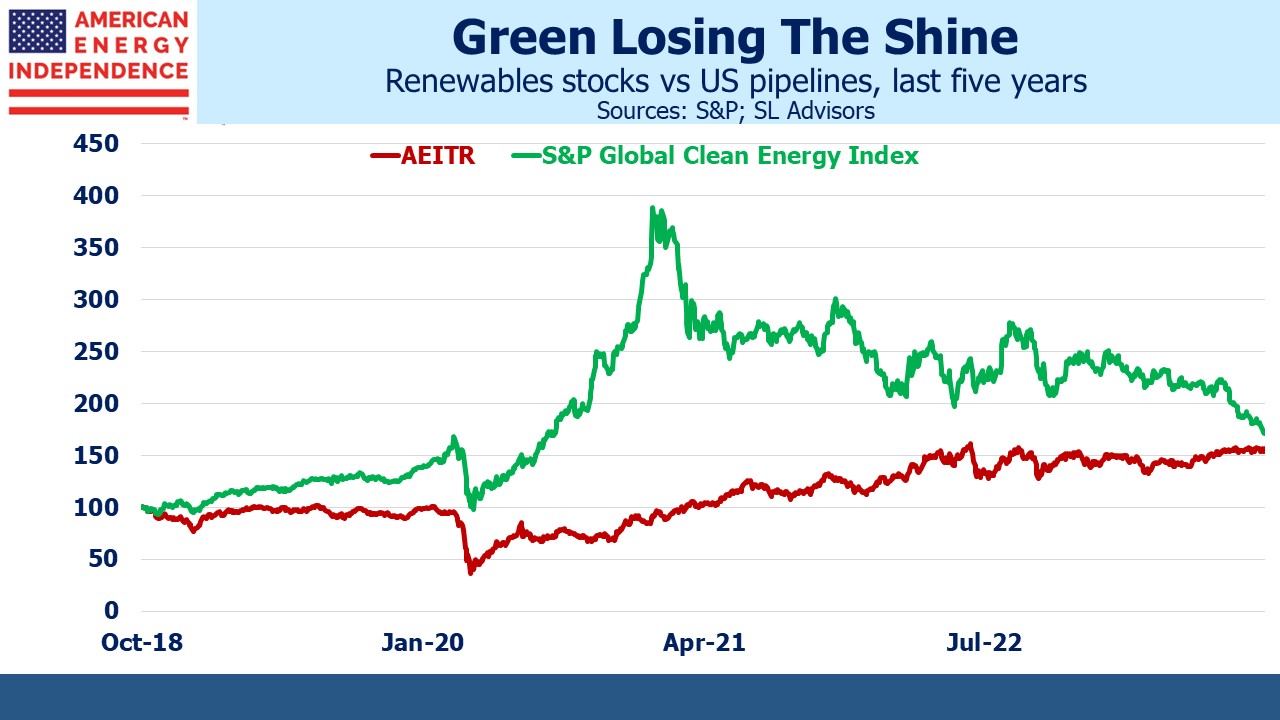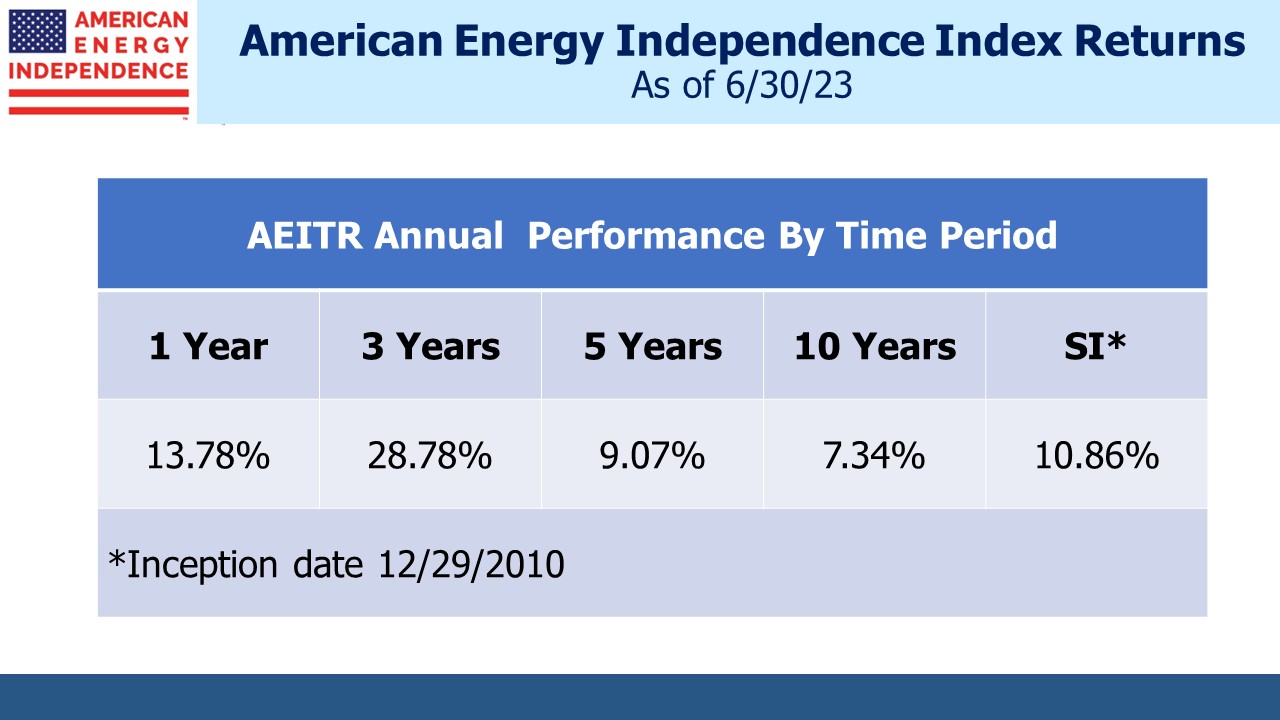Green Growth Projects Are Losing Fans
On Sunday my daughter lamented the fact that she didn’t have a ticket for the Chiefs-Jets game that evening. Not that she’s an NFL fan – she was blissfully unaware of the injury that Aaron Rodgers sustained three weeks ago and has no experience of the perpetual heartache Jets fans stoically endure. She just wanted to see Taylor Swift waving at Travis Kelce from the VIP section. The Chiefs provided plenty to wave at.
Even the Bills 48-20 demolition of the Dolphins, coming a week after the Dolphins mauled the Broncos 70-20, couldn’t beat Taylor Swift as the opening paragraph in the WSJ’s Jason Gay NFL column on Monday. We’re simply following the trend.
Almost as important was the rebalancing of the Alerian index now that it’s lost Magellan Midstream to Oneok and will soon cede Crestwood to Energy Transfer. Vettafi, owner of the indices, opted to move beyond pipelines in its quest for more MLPs. Among the additions is USA Compression Partners which provides compression services that keep oil and gas moving through pipelines. They’re in the equipment services business, without the visible cashflows that characterize the pipeline toll model. USAC’s business is cyclical and competitive. They don’t enjoy the regulated monopolies of pipelines with PPI-linked tariff increases. High profits at USAC will draw new providers of such services. The MLP fund managers whose indices will now include USAC must choose to underweight it or accept more energy cycle risk. Investors in the Alerian MLP ETF, AMLP, will have no choice.
I remember meeting USAC’s CEO several years ago at a conference and asking him why they were still pursuing growth strategies that didn’t cover their cost of capital. He responded that if Chevron asks you whether you’ll be there for them in a new oil or gas play, you have to say yes. That’s the attitude that caused poor capital allocation at the height of the shale revolution.
Mizuno’s Gabriel Moreen, who covers the midstream sector, just downgraded USAC to underperform, saying the company, “does not possess the balance sheet flexibility to lean into growth” even if such opportunities present themselves.
Five years ago and before the pandemic, renewables stocks were starting their ascent on the belief that a fast energy transition was beginning and oil and gas assets would be stranded. Covid represented a brief setback, but the rally soon resumed. Early 2021 marked the peak in sentiment, and the deflating bubble has spread misery ever since.
Midstream energy infrastructure looks like the tortoise gaining on the clean energy hare. Five year returns are converging and on present trends it shouldn’t be too long before investors in green energy are forced to conclude pipelines were better. The enthusiasm of management teams for deploying new capital is not shared by the market.
NextEra Partners, LP (NEP), has lost almost half its value following last week’s revised guidance on distribution growth, down from a range of 12-15% to 5-8%. The market’s reaction was as if they’d slashed their payout instead of simply reducing its projected growth rate, although the current 12% yield suggests many think it will be cut anyway.
Rising interest rates have hurt companies promising high growth, including renewables. Meanwhile traditional energy companies remain content with parsimonious capex growth and high current returns.
NEP is an old-style MLP with an external General Partner (GP) in parent NextEra Energy Inc (NEE). As with the pipeline GP/MLP combinations that have disappeared, NEE sells assets to NEP who issues equity to pay for them. Pricing is supposed to be arms’ length but historically the GP has done better than the MLP, just as hedge fund managers have done better than hedge fund investors (see The Hedge Fund Mirage).
NEP tried to soften the bad news by promising no need for additional growth equity (ie secondary offerings) until 2027. However, investors were apparently unexcited about plans to “repower the majority of its wind portfolio in the coming years” which means upgrade old equipment, or the “excellent growth opportunities” from acquiring assets from the parent.
MLPs have a narrow investor base, mostly income-seeking US taxpayers willing to tolerate a K1 (ie old rich Americans) and a few energy funds. Mistreating this investor base depresses the stock price, rendering it a prohibitively expensive source of capital which in turn makes it hard for the parent to drop down assets. Former investors in Kinder Morgan Partners know what comes next (see Kinder Shows The MLP Model is Changing). The MLP gets rolled up into the parent at a low price, delivering LPs an unwelcome tax bill for deferred income recapture.
NEP CEO John Ketchum has arranged his own investments accordingly. His holdings of NEE, where he is also CEO, are more than 10X his holdings of NEP. He’s seen this movie before.
We three have funds that seek to profit from this environment:

